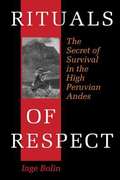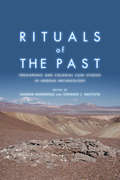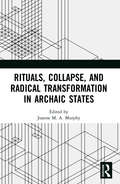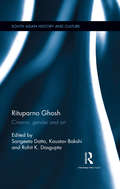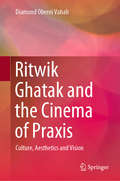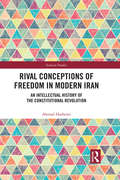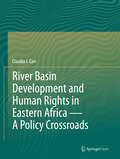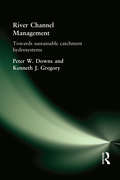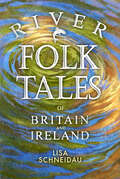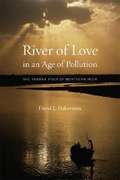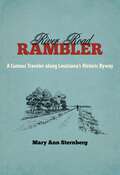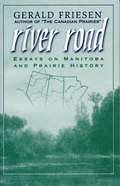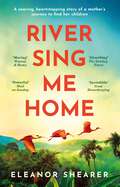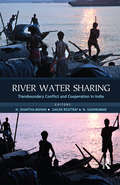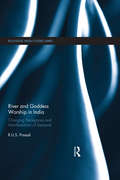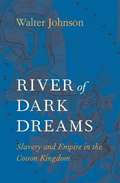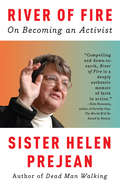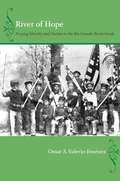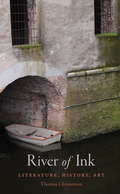- Table View
- List View
Rituals of Migration: Italians and Irish on the Move (The Glucksman Irish Diaspora Series)
by Kevin Kenny Maddalena MarinariItalian and Irish immigrant experiencesWhen people migrate, they often perform social and cultural rituals along the way. The idea of rites of passage—with its elements of preparation, departure, transit, admission, exclusion, expulsion, and return—helps us understand these moments in the process of migration in new and meaningful ways.Rituals of Migration offers snapshots of Italian and Irish migrants on the move from the mid-nineteenth to mid-twentieth centuries. The essays in this volume examine the particular moments, actions, sentiments, and material objects in the process of migration—at the point of departure, in transit, and in the process of return. Because rites and rituals feature both nonverbal and verbal expression, migration history can be understood by studying physical objects as well as written sources. The authors focus on rituals created by migrants and their descendants, but they also consider the actions of officials who regulated migrants’ departure, travel, admission, exclusion, and removal. By examining what people did, thought, felt, and packed on the eve of their departures, during their journeys, and when returning to their homelands, Rituals of Migration reveals how everyone involved in the immigration process, including the migrants themselves, the families they left behind, and those in charge of regulating their mobility, have tried to make sense of a process filled with peril, uncertainty, excitement, and opportunity.
Rituals of Resistance: African Atlantic Religion in Kongo and the Lowcountry South in the Era of Slavery
by Jason R. YoungIn Rituals of Resistance Jason R. Young explores the religious and ritual practices that linked West-Central Africa with the Lowcountry region of Georgia and South Carolina during the era of slavery. The choice of these two sites mirrors the historical trajectory of the transatlantic slave trade which, for centuries, transplanted Kongolese captives to the Lowcountry through the ports of Charleston and Savannah. Analyzing the historical exigencies of slavery and the slave trade that sent not only men and women but also cultural meanings, signs, symbols, and patterns across the Atlantic, Young argues that religion operated as a central form of resistance against slavery and the ideological underpinnings that supported it. Through a series of comparative chapters on Christianity, ritual medicine, burial practices, and transmigration, Young details the manner in which Kongolese people, along with their contemporaries and their progeny who were enslaved in the Americas, utilized religious practices to resist the savagery of the slave trade and slavery itself. When slaves acted outside accepted parameters -- in transmigration, spirit possession, ritual internment, and conjure -- Young explains, they attacked not only the condition of being a slave, but also the systems of modernity and scientific rationalism that supported slavery. In effect, he argues, slave spirituality played a crucial role in the resocialization of the slave body and behavior away from the oppressions and brutalities of the master class. Young's work expands traditional scholarship on slavery to include both the extensive work done by African historians and current interdisciplinary debates in cultural studies, anthropology, and literature.Drawing on a wide range of primary sources from both American and African archives, including slave autobiography, folktales, and material culture, Rituals of Resistance offers readers a nuanced understanding of the cultural and religious connections that linked blacks in Africa with their enslaved contemporaries in the Americas. Moreover, Young's groundbreaking work gestures toward broader themes and connections, using the case of the Kongo and the Lowcountry to articulate the development of a much larger African Atlantic space that connected peoples, cultures, languages, and lives on and across the ocean's waters.
Rituals of Respect
by Inge Bolin"In the remoteness of their mountain retreat, the herders of Chillihuani, Peru, recognize that respect for others is the central and most significant element of all thought and action," observes Inge Bolin. "Without respect, no society, no civilization, can flourish for long. Without respect, humanity is doomed and so is the earth, sustainer of all life. " In this beautifully written ethnography, Bolin describes the rituals of respect that maintain harmonious relations among people, the natural world, and the realm of the gods in an isolated Andean community of llama and alpaca herders that reaches up to 16,500 feet. Bolin was the first foreigner to visit Chillihuani, and she was permitted to participate in private family rituals, as well as public ceremonies. In turn, she allows the villagers to explain the meaning of their rituals in their own words. From these first-hand experiences, Bolin offers an intimate portrait of an annual ritual cycle that dates back to Inca and pre-Inca times, including the ancient Pukllay; weddings; the Fiesta de Santiago, with its horse races on the top of the world; and Peru's Independence Day, when the Rituals of Respect for elders and young people alike are carried out within male and female hierarchies reminiscent of Inca times.
Rituals of the Past: Prehispanic and Colonial Case Studies in Andean Archaeology
by Silvana A. Rosenfeld and Stefanie L. BautistaRituals of the Past explores the various approaches archaeologists use to identify ritual in the material record and discusses the influence ritual had on the formation, reproduction, and transformation of community life in past Andean societies. A diverse group of established and rising scholars from across the globe investigates how ritual influenced, permeated, and altered political authority, economic production, shamanic practice, landscape cognition, and religion in the Andes over a period of three thousand years. Contributors deal with theoretical and methodological concerns including non-human and human agency; the development and maintenance of political and religious authority, ideology, cosmologies, and social memory; and relationships with ritual action. The authors use a diverse array of archaeological, ethnographic, and linguistic data and historical documents to demonstrate the role ritual played in prehispanic, colonial, and post-colonial Andean societies throughout the regions of Peru, Chile, Bolivia, and Argentina. By providing a diachronic and widely regional perspective, Rituals of the Past shows how ritual is vital to understanding many aspects of the formation, reproduction, and change of past lifeways in Andean societies. Contributors: Sarah Abraham, Carlos Angiorama, Florencia Avila, Camila Capriata Estrada, David Chicoine, Daniel Contreras, Matthew Edwards, Francesca Fernandini, Matthew Helmer, Hugo Ikehara, Enrique Lopez-Hurtado, Jerry Moore, Axel Nielsen, Yoshio Onuki, John Rick, Mario Ruales, Koichiro Shibata, Hendrik Van Gijseghem, Rafael Vega-Centeno, Verity Whalen
Rituals, Collapse, and Radical Transformation in Archaic States
by Murphy, Joanne M. A.Rituals, Collapse, and Radical Transformation in Archaic States explores the role of ritual in a variety of archaic states and generates discussion on how the decline in a state’s ability to continue in its current form affected the practices of ritual and how ritual as a culture-forming dynamic affected decline, collapse, and regeneration of the state. Chapters examine ritual in collapsing and regenerating archaic states from diverse locations, time periods, and societies including Crete, Mycenean and Byzantine Greece, Mesopotamia, India, Africa, Mexico, and Peru. Underscoring similarities in a variety of archaic states in the role of ritual during periods of threat, collapse, and transformation, the volume shows how ritual can be used as a stabilizing or divisive force or a connecting medium between the present to the past in an empowering way. It also highlights the diversity of ritual roles and location in similar situations and illustrates how states in close proximity and sharing many cultural similarities can respond differently through ritual to stress and contrast the different response in rural and urban settings. Through detailed, cultural specific studies, the book provides a nuanced understanding of the diverse roles of ritual in the decline, collapse, and regeneration of societies and will be important for all archaeologists involved in the important notions of state "collapse" and "regeneration".
Rituparno Ghosh: Cinema, gender and art (South Asian History and Culture)
by Rohit K. Dasgupta Sangeeta Datta Kaustav BakshiAn iconic filmmaker and inheritor of the legendary Satyajit Ray’s legacy, Rituparno Ghosh was one of the finest auteurs to emerge out of contemporary Bengal. His films, though rooted firmly in middle-class values, desires and aspirations, are highly critical of hetero-patriarchal power structures. From the very outset, Ghosh displayed a strong feminist sensibility which later evolved into radical queer politics. This volume analyses his films, his craft, his stardom and his contribution to sexual identity politics. In this first scholarly study undertaken on Rituparno Ghosh, the essays discuss the cultural import of his work within the dynamics of a rapidly evolving film industry in Bengal and more largely the cinematic landscape of India. The anthology also contains a conversation section (interviews with the filmmaker and with industry cast and crew) drawing a critical and personal portrait of this remarkable filmmaker.
Ritwik Ghatak and the Cinema of Praxis: Culture, Aesthetics and Vision
by Diamond Oberoi VahaliIn a significant departure from other works on Ritwik Ghatak, this book establishes him as an auteur and a maestro on par with some of the great film directors, like Sergei Eisenstein, Satyajit Ray, Ingmar Bergman, Federico Fellini, Kenji Mizoguchi and Luis Bunuel. Based on in-depth research that follows Ghatak’s journey within the context of the Indian People’s Theatre Association, it fills an important gap in the scholarship around Ghatak by offering crucial insights into Ghatak’s unique vision of cinema embedded as it is in the cultural psychic configurations of the people. It analyses Ghatak’s practice by minutely tracing formal similarities across the language of his cinematic oeuvre in the domain of cinematography, lighting, music, and sound. The book develops the way in which cinematic technique enters the domain of conceptual constructs and abstractions. It moves on to chronicle Ghatak’s political odyssey as reflected in his cinema. Moreover, it charts the manner in which Ghatak, through his cinematic idiom, offers a polemic of cinema that further adds to his notion of praxis – a thoughtful Marxist paradigm organically associated with the culture and context of India. By locating Ghatak within the discourse of nationalism, the book brings to the surface Ghatak’s critical insights related to the independence of the nation and the trauma of the partition of Bengal. Ghatak’s cinema served the crucial function of chronicling the mass tragedy of partition and its impact on the human psyche.This book appeals to scholars of film studies and filmmaking as well as to researchers and general readers interested in debates pertaining to culture, politics, art, psychoanalysis, partition and refugee studies, cinema, theatre, and ideology.
Rival Conceptions of Freedom in Modern Iran: An Intellectual History of the Constitutional Revolution (Iranian Studies)
by Ahmad HashemiRival Conceptions of Freedom in Modern Iran is an original historiographic examination of the idea of freedom in early modern Iran within a larger context of the formation of modern Muslim thought. The study develops an appropriate method for the historiography of ideas by taking into consideration cultural, linguistic, and socio-political limitations and obstacles to free thinking in closed societies. The research shows how most locutions about freedom, uttered during early modern Iran, were formed within the horizon of the question of Iran’s decline and were somehow related to remedying such situations. It challenges previous studies which employed Isaiah Berlin’s distinction between positive and negative freedom as two fundamentally different concepts of freedom. It replaces Berlin’s dichotomy of positive and negative liberties with MacCallum’s triadic concept of freedom and argues that thinkers in early modern Iran could noticeably present rival interpretations of three variables of the concept of freedom, namely the agent, the constraint, and the purpose of freedom. Rival Conceptions of Freedom in Modern Iran is a unique contribution to the histories of the 1905-11 Constitutional Revolution in Iran and comparative political thinking between Iran and Europe. It is an essential resource for scholars interested in Constitutionalism, History, Political Theory and Sociology within Middle Eastern Studies.
Rivalry and Revolution in South and East Asia (Routledge Revivals)
by Partha S. GhoshFirst published in 1997, this study reveals the forces of nationalism and internationalism at work side by side in the populous and volatile regions of South and East Asia which make up the 11 chapters of this volume. They cover regional security, political economy, territorial disputes and national unification. Problems such as those of Cambodia and the nuclearization of India, Pakistan and North Korea create serious international concern, while unresolved regional issues force nationalistic and military conflict. The irresistible popular pressure for economic integration with the global system, often without any corresponding commitment to political freedom, underlies it all. The cumulative effect of these diverse processes creates an explosive mix of international rivalries and national revolutions which raises the question of the possible arrival of the ‘Asian Century’.
River Basin Development and Human Rights in Eastern Africa — A Policy Crossroads
by Claudia J. CarrThis open access book can be downloaded from link.springer.com This book offers a devastating look at deeply flawed development processes driven by international finance, African governments and the global consulting industry. It examines major river basin development underway in the semi-arid borderlands of Ethiopia, Kenya and South Sudan and its disastrous human rights consequences for a half-million indigenous people. The volume traces the historical origins of Gibe III megadam construction along the Omo River in Ethiopia—in turn, enabling irrigation for commercial-scale agricultural development and causing radical reduction of downstream Omo and (Kenya's) Lake Turkana waters. Presenting case studies of indigenous Dasanech and northernmost Turkana livelihood systems and Gibe III linked impacts on them, the author predicts agropastoral and fishing economic collapse, region-wide hunger with exposure to disease epidemics, irreversible natural resource destruction and cross-border interethnic armed conflict spilling into South Sudan. The book identifies fundamental failings of government and development bank impact assessments, including their distortion or omission of mandated transboundary assessment, cumulative effects of the Gibe III dam and its linked Ethiopia-Kenya energy transmission 'highway' project, key hydrologic and human ecological characteristics, major earthquake threat in the dam region and widespread expropriation and political repression. Violations of internationally recognized human rights, especially by the Ethiopian government but also the Kenyan government, are extensive and on the increase—with collaboration by the development banks, in breach of their own internal operational procedures. A policy crossroads has now emerged. The author presents the alternative to the present looming catastrophe—consideration of development suspension in order to undertake genuinely independent transboundary assessment and a plan for continued development action within a human rights framework—forging a sustainable future for the indigenous peoples now directly threatened and for their respective eastern Africa states. Claudia Carr’s book is a treasure of detailed information gathered over many years concerning river basin development of the Omo River in Ethiopia and its impact on the peoples of the lower Omo Basin and the Lake Turkana region in Kenya. It contains numerous maps, charts, and photographs not previously available to the public. The book is highly critical of the environmental and human rights implications of the Omo River hydropower projects on both the local ethnic communities in Ethiopia and on the downstream Turkana in Kenya. David Shinn Former Ambassador to Ethiopia and to Burkina Faso Adjust Professor of International Affairs, The George Washington University, Washington D.C.
River Channel Management: Towards sustainable catchment hydrosystems
by Peter Downs Ken GregoryRiver Channel Management is the first book to deal comprehensively with recent revolutions in river channel management. It explores the multi-disciplinary nature of river channel management in relation to modern management techniques that bear the background of the entire drainage basin in mind, use channel restoration where appropriate, and are designed to be sustainable.River Channel Management is divided into five sections: ·The Introduction outlines the need for river channel management .·Retrospective Review offers an overview of twentieth century engineering methods and the ways that river channel systems operate. ·Realisation explains how greater understanding of river channel adjustments, channel hazards and river basin planning created a context for twenty-first century management.·Requirements for Management explains and examines environmental assessment, restoration-based approaches, and methods that work towards 'design with nature'·Final Revision speculates about prospects for twenty-first century river channel management. River Channel Management is written for higher-level undergraduates and for postgraduates in geography, ecology, engineering, planning, geology and environmental science, for professionals involved in river channel management, and for staff in environmental agencies.
River Folk Tales of Britain and Ireland (Folk Tales)
by Lisa SchneidauRivers and streams sculpt our landscape, and have connected our communities throughout history, from mountain to estuary and to the wide sea beyond. They give us water and food, trade and transport – yet they have a life-force all of their own.In this collection of traditional folk tales from wild rivers, lakes, and streams, Lisa Schneidau retells old stories of danger and transformation, of river goddesses, ghosts and the mysterious creatures that dwell in the watery arteries of Britain and Ireland.
River Life and the Upspring of Nature
by Naveeda KhanIn River Life and the Upspring of Nature Naveeda Khan examines the relationship between nature and culture through the study of the everyday existence of chauras, the people who live on the chars (sandbars) within the Jamuna River in Bangladesh. Nature is a primary force at play within this existence as chauras live itinerantly and in flux with the ever-changing river flows; where land is here today and gone tomorrow, the quality of life itself is intertwined with this mutability. Given this centrality of nature to chaura life, Khan contends that we must think of nature not simply as the physical landscape and the plants and animals that live within it but as that which exists within the social and at the level of cognition, the unconscious, intuition, memory, embodiment, and symbolization. By showing how the alluvial flood plains configure chaura life, Khan shows how nature can both give rise to and inhabit social, political, and spiritual forms of life.
River Of Love In An Age Of Pollution: The Yamuna River Of Northern India
by David L. HabermanCelebrated as an aquatic form of divinity for thousands of years, the Yamuna is one of India's most sacred rivers. A prominent feature of north Indian culture, the Yamuna is conceptualized as a goddess flowing with liquid love -- yet today it is severely polluted, the victim of fast-paced industrial development. <P> This fascinating and beautifully written book investigates the stories, theology, and religious practices connected with this river goddess collected from texts written over several millennia, as well as from talks with pilgrims, priests, and worshippers who frequent the pilgrimage sites and temples located on her banks. <P> David L. Haberman offers a detailed analysis of the environmental condition of the river and examines how religious practices are affected by its current pollution. He introduces Indian river environmentalism, a form of activism that is different in many ways from its western counterpart. River of Love in an Age of Pollution concludes with a consideration of the broader implications of the Yamuna's plight and its effect on worldwide efforts to preserve our environment.
River Road Rambler: A Curious Traveler along Louisiana's Historic Byway (Southern Literary Studies)
by Mary Ann SternbergThe River Road between New Orleans and Baton Rouge hosts a fascinating mix of people, traditions, and stories. Author Mary Ann Sternberg has spent over two decades exploring this historic corridor, uncovering its intriguing and often-underappreciated places. In River Road Rambler, she presents fifteen sketches about sites along this scenic route. From familiar stops, such as the National Hansen's Disease Center Museum at Carville and the perique tobacco area of St. James Parish to lesser-known attractions such as Our Lady of Lourdes grotto in the town of Convent and the Colonial Sugars Historic District, Sternberg provides a new perspective on some of the region's most colorful places. While many of these locales remain easily accessible to any River Road rambler, Sternberg also depicts others closed to the public, giving armchair travelers an introduction to these otherwise unreachable attractions. Throughout, Sternberg captures the ambiance of her surroundings with a clear, engaging, and personal examination of the relationships between past and present. In a poignant piece on the garden of "Valcour" Aime, for example, she delves into the history of this lavish, nationally acclaimed planter's garden, established and abandoned in the mid-nineteenth century. Her visit to the now-private and protected site, which has never been altered or replanted, uncovers an extraordinary landscape -- the relic of what Aime created, slowly overwhelmed by nature. These sketches brim with insights and observations about everything from the fire that razed The Cottage plantation to the failed attempts to salvage the reproduction of the seventeenth-century French warship Le Pelican from the bottom of the Mississippi. River Road Rambler links us to both past and present while revealing delightful and unexpected surprises only found along this storied byway.
River Road: Essays on Manitoba and Prairie History
by Gerald FriesenThe prairies are a focal point for momentous events in Canadian history, a place where two visions of Canada have often clashed: Louis Riel, the Manitoba School Question, French language rights, the 1919 Winnipeg General Strike, and the dramatic collapse of the Meech Lake Accord when MLA Elijah Harper voted “No.”Gerald Friesen believes that it is the responsibility of the historian to “tell local stories in terms and concepts that make plain their intrinsic value and worth, that explain the relationship between the past and the present.” For local experiences to have any relevant meaning, they must be put into the context of the wider world.These essays were written for the general reader and the academic historian. They include previously published works (many of them revised and updated) from a wide variety of sources, and new pieces written specifically for River Road, examining aspects of prairie and Manitoba history from many different perspectives. They offer portraits of representatives from different sides of the prairie experience, such as Bob Russell, radical socialist and leader of the 1919 General Strike, and J.H. Riddell, conservative Methodist minister who represented “sane and safe” stewardship in the 1920s and 1930s. They explore the changing relationship between Aboriginal peoples and the “dominant” society, from the prosperous Metis community that flourished along the Red River in the 19th century (and produced Manitoba’s first Metis premier) to the events that led to the Manitoba Aboriginal Justice Inquiry in the 1980s.Other essays consider new viewpoints of the prairie past, using the perspectives of ethnic and cultural history, women’s history, regional history, and labour history to raise questions of interpretation and context. The time frame considered is equally wide-ranging, from the Aboriginal and Red River society to the political arena of current constitutional debates.
River Sing Me Home: A powerful, luminous and redemptive novel of a mother's search for her children
by Eleanor ShearerPowerful, moving and redemptive, RIVER SING ME HOME tells of a mother's desperate search to find her stolen children and her freedom. We whisper the names of the ones we love like the words of a song. That was the taste of freedom to us, those names on our lips. Mary Grace, Micah, Thomas Augustus, Cherry Jane and Mercy. These are the names of her children. The five who survived, only to be sold to other plantations. The faces Rachel cannot forget. It's 1834, and the law says her people are now free. But for Rachel freedom means finding her children, even if the truth is more than she can bear. With fear snapping at her heels, Rachel keeps moving. From sunrise to sunset, through the cane fields of Barbados to the forests of British Guiana and on to Trinidad, to the dangerous river and the open sea. Only once she knows their stories can she rest.Only then can she finally find home.(P) 2023 Headline Publishing Group Ltd
River Sing Me Home: A powerful, luminous and redemptive novel of a mother's search for her children
by Eleanor ShearerGripping, soaring and redemptive, RIVER SING ME HOME tells of a mother's journey to find her children.'A strong and beautiful novel that stares into the face of brutality and the heart of love' Jeanette Winterson'Magnificent and epic. A story about love and the power it brings us' ' Frank Cottrell-Boyce 'A powerful story, beautifully told' Jessica Moor'It slices you open, lays out your parts, reassembles them and knits you back up again. A powerful account of love, loss, defiance... Breathtaking' Chikodili Emelumadu 'Beautiful... A masterclass in how to speak of unspeakable things' Meg Clothier----------------------------We whisper the names of the ones we love like the words of a song. That was the taste of freedom to us, those names on our lips. Mary Grace, Micah, Thomas Augustus, Cherry Jane and Mercy. These are the names of her children. The five who survived, only to be sold to other plantations. The faces Rachel cannot forget. It's 1834, and the law says her people are now free. But for Rachel freedom means finding her children, even if the truth is more than she can bear. With fear snapping at her heels, Rachel keeps moving. From sunrise to sunset, through the cane fields of Barbados to the forests of British Guiana and on to Trinidad, to the dangerous river and the open sea. Only once she knows their stories can she rest. Only then can she finally find home.Inspired by the women who, in the aftermath of slavery, went in search of their lost children. ----------------------------'An immersive debut. A tender exploration of one woman's courage in the face of unbelievable cruelty. The heart of the novel lies in its celebration of motherhood and female resilience' Observer'The compelling premise of a mother in search of her children powers a moving and dynamic novel' Guardian 'A powerful, gripping novel about the strength of a mother's love' Red - The best books of January 2023'Full of love and compassion, this will be everywhere next year' Stylist - Pick of the big fiction books for 2023'Powerful, moving and lyrical' Woman & Home'A glorious and compelling story' Prima'Eleanor Shearer is a remarkable writer' Natasha Lester'An extraordinary odyssey of pain, love, and homecoming' Kate Quinn'A stunning debut with real characters that lock themselves in your heart' Sadeqa Johnson'A searing debut. Heartbreaking, hopeful, and unforgettable' Kristin Harmel'An extraordinary and gripping debut. A must-read' Chanel Cleeton'Lyrical, heartbreaking, thought-provoking' Costanza Casati
River Systems of West Bengal: Water and Environments (Springer Water)
by Gautam Kumar DasThe book explains the basic concepts of river water quality index, river environments, shifting of river courses, dams and barrages – their merits and demerits, mutual interdependence of river and society etc. in the typical geomorphic set up of West Bengal. In India, West Bengal is a riverine state due to the towering Himalayas to the north and the Bay of Bengal to the south. In between the mountain and sea, due to the location of the Gangetic delta region and its stability with space and time, the rivers of this state are gradually dying. In addition to the stability of the delta, the river channel is being filled with sediments carried along the river course from upstream. The role of dams, barrages and reservoirs in the normal flow of rivers at different geographical locations deserves discussion which is included in the book. It is to be expected that the rivers of West Bengal can be an outstanding example of mutual interdependence of science and society, all of which are included in the book.The use of different physicochemical parameters adopted for the water quality index of different rivers described in this book will provide new directions in this regard. With discussions like water quality index, river environments, shifting of river courses, reservoirs, dams and barrages, and mutual interdependence of river and society, it is the intention that this book, River Systems of West Bengal - Water and Environments, will be useful for the research and higher studies in the river related field. This book will be of interest to students and researchers of riverine environments.
River Water Sharing: Transboundary Conflict and Cooperation in India
by N. Shantha MohanThis volume provides a broad perspective of the water scenario in India by examining the various developments in the sector and the emerging alternative paradigms. It points out the inadequacies of the existing legal frameworks and institutional mechanisms to manage water efficiently.
River and Goddess Worship in India: Changing Perceptions and Manifestations of Sarasvati (Routledge Hindu Studies Series)
by R.U.S. PrasadSarasvati assumes different roles, a physical river and a river goddess, then as a goddess of speech and finally that of a goddess of learning, knowledge, arts and music. References to Sarasvati in the Vedas and the Brahmanas, the Mahabharata and the Puranas and her marked presence in other religious orders, such as Buddhism, Jainism and the Japanese religion, form the basis of discussion as regards her various attributes and manifestations. In Jainism, her counter-part is Sutra-devi, in Buddhism it is Manjusri and Prajnaparamita and in the Japanese religion, Benten is the representative goddess. The physical presence of Sarasvati in various iconic forms is seen in Nepal, Tibet and Japan. Tantrism associated with Sarasvati also finds reflection in these religious traditions. Sculptors and art historians take delight in interpreting various symbols her iconic forms represent. The book examines Sarasvati’s origin, the course of her flow and the place of her disappearance in a holistic manner. Based on a close analysis of texts from the early Rig-Veda to the Brahmanas and the Puranas, it discusses different view-points in a balanced perspective and attempts to drive the discussions towards the emergence of a consensus view. The author delineates the various phases of Sarasvati’s evolution to establish her unique status and emphasise her continued relevance in the Hindu tradition. The book argues that the practice of pilgrimage further evolved after its association with the river Sarasvati who was perceived as divinity personified in Hindu tradition. This, in turn, led to the emergence of numerous pilgrimage sites on or near her banks which attracted a large number of pilgrims. A multifaceted and interdisciplinary analysis of a Hindu goddess, this book will be of interest to academics researching South Asian Religion, Hinduism and Indian Philosophy as also the general readers.
River of Dark Dreams: Slavery and Empire in the Cotton Kingdom
by Walter JohnsonRiver of Dark Dreams places the Cotton Kingdom at the center of worldwide webs of exchange and exploitation that extended across oceans and drove an insatiable hunger for new lands. This bold reaccounting dramatically alters our understanding of American slavery and its role in U. S. expansionism, global capitalism, and the upcoming Civil War.
River of Fire: My Spiritual Journey
by Helen Prejean“River of Fire is Sister Helen’s story leading up to her acclaimed book Dead Man Walking—it is thought-provoking, informative, and inspiring. Read it and it will set your heart ablaze!”—Mark Shriver, author of Pilgrimage: My Search for the Real Pope Francis The nation’s foremost leader in efforts to abolish the death penalty shares the story of her growth as a spiritual leader, speaks out about the challenges of the Catholic Church, and shows that joy and religion are not mutually exclusive. Sister Helen Prejean’s work as an activist nun, campaigning to educate Americans about the inhumanity of the death penalty, is known to millions worldwide. Less widely known is the evolution of her spiritual journey from praying for God to solve the world’s problems to engaging full-tilt in working to transform societal injustices. Sister Helen grew up in a well-off Baton Rouge family that still employed black servants. She joined the Sisters of St. Joseph at the age of eighteen and was in her forties when she had an awakening that her life’s work was to immerse herself in the struggle of poor people forced to live on the margins of society. Sister Helen writes about the relationships with friends, fellow nuns, and mentors who have shaped her over the years. In this honest and fiercely open account, she writes about her close friendship with a priest, intent on marrying her, that challenged her vocation in the “new territory of the heart.” The final page of River of Fire ends with the opening page of Dead Man Walking, when she was first invited to correspond with a man on Louisiana’s death row. River of Fire is a book for anyone interested in journeys of faith and spirituality, doubt and belief, and “catching on fire” to purpose and passion. It is a book, written in accessible, luminous prose, about how to live a spiritual life that is wide awake to the sufferings and creative opportunities of our world.“Prejean chronicles the compelling, sometimes-difficult journey to the heart of her soul and faith with wit, honesty, and intelligence. A refreshingly intimate memoir of a life in faith.”—Kirkus Reviews
River of Hope: Forging Identity and Nation in the Rio Grande Borderlands
by Omar S. Valerio-JiménezIn River of Hope, Omar S. Valerio-Jiménez examines state formation, cultural change, and the construction of identity in the lower Rio Grande region during the eighteenth and nineteenth centuries. He chronicles a history of violence resulting from multiple conquests, of resistance and accommodation to state power, and of changing ethnic and political identities. The redrawing of borders neither began nor ended the region's long history of unequal power relations. Nor did it lead residents to adopt singular colonial or national identities. Instead, their regionalism, transnational cultural practices, and kinship ties subverted state attempts to control and divide the population.Diverse influences transformed the borderlands as Spain, Mexico, and the United States competed for control of the region. Indian slaves joined Spanish society; Mexicans allied with Indians to defend river communities; Anglo Americans and Mexicans intermarried and collaborated; and women sued to confront spousal abuse and to secure divorces. Drawn into multiple conflicts along the border, Mexican nationals and Mexican Texans (tejanos) took advantage of their transnational social relations and ambiguous citizenship to escape criminal prosecution, secure political refuge, and obtain economic opportunities. To confront the racialization of their cultural practices and their increasing criminalization, tejanos claimed citizenship rights within the United States and, in the process, created a new identity.Published in cooperation with the William P. Clements Center for Southwest Studies, Southern Methodist University.
River of Ink: [An Illustrated History of Literacy]
by Thomas ChristensenThomas Christensen's previous title 1616: The World in Motion looked at a single year in the age of early maritime globalism--PW gave it a starred review, calling it "a stunning overview of the nascent modern world." By contrast his new gorgeously illustrated River of Ink ranges widely across time and cultures and offers what amounts to a magisterial history of literacy.The book's title refers to the sacking of Baghdad in 1258 when the Tigris ran black with the ink of books flung into the water by Mongol invaders. Other essays range from the writings of prehistoric Chinese cultures known only through archaeology to the state of book reviewing in the US today to the heroic efforts of contemporary Afghanis to keep the legacy of their ancient culture alive under the barrage of endless war.Christensen's encyclopaedic knowledge of both world art and a vast understand of literature allows him to move easily from a discussion of the invention of moveable type in Korea to Johannes Kepler's search for the harmony of the spheres to the strange journey of an iron sculpture from Benin to the Louvre. Other essays cover the Popul Vuh of the Maya as exemplum of translation, the pioneering explorations of the early American naturalist John Bartram, the balletic works of Louis-Ferdinand Celine.It is Christensen's unparalleled gift to seemingly see the world whole and to offer a wealth of absolutely vital connections adequate to our position as citizens of an ever more rapidly globalizing world.


